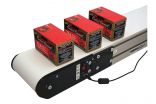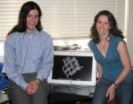HARTLAND, WI, November 12, 2010 (Press-News.org) Faster speeds, increased weight capacity and indexing capabilities are the characteristics driving Dorner's new 3200 Series iDrive belt conveyor.
The iDrive Series, which debuted last year on Dorner's 2200 Series conveyors, represents the latest in conveyor innovation: integrating the motor, gearbox and motor controller all within the frame of the conveyor. This sleek, space-saving design allows the conveyor to fit into the tightest of spaces without worry.
Seen as the big brother to the 2200 Series iDrive, the 3200 Series iDrive conveyor is designed for more heavy-duty industrial and packaging applications. Its robust frame and motor can carry more weight, operate at faster speeds and is available in larger sizes. The conveyor also comes with indexing capabilities to handle more sophisticated conveying applications. This new addition from Dorner gives customers greater flexibility in selecting the right iDrive conveyor to meet their exact application needs. Plus, both iDrive series are designed for making automation better with years of worry-free operation.
The 3200 Series iDrive comes with three control options and is ready to use for quick integration into existing packaging and processing lines. Side controls allow operators to adjust speed and direction with ease, and an internal brushless DC motor is maintenance free.
The 3200 Series iDrive incorporates many of the same user-friendly features found on Dorner's main 3200 Series platform including:
- V-guided belts for maintenance-free tracking
- Rack and pinion belt tension
- Built-in tension indicators
- Two T-slots for fast mounting of automation components
- Quick five-minute belt changes
The 3200 Series iDrive conveyor can be built and shipped within 10 days of order. For more information on the new 3200 Series iDrive conveyor, visit www.dornerconveyors.com.
Hartland, Wisconsin-based Dorner Manufacturing is a world leader in the design, manufacture and distribution of high-quality conveyors and related equipment. Since 1973, companies from around the world have turned to Dorner conveyors for greatly improved efficiency and productivity. For more information about products or company news, visit Dorner's Web site at www.dornerconveyors.com or call 1-800-397-8664.
Dorner's New iDrive Conveyor Adds Speed, Capacity for Tight-Space Packaging and Industrial Applications
Faster speeds, increased weight capacity make the 3200 iDrive Series belt conveyor ideal for the automation, packaging and food industries.
2010-11-12
ELSE PRESS RELEASES FROM THIS DATE:
New class of 'dancing' dendritic cells derived from blood monocytes
2010-11-11
Dendritic cells, known to be the prime movers of the body's immune response, are still notoriously difficult to study in humans. Samples, which come primarily from bone marrow or lymphoid tissue, are simply too difficult to obtain. But new research at Rockefeller University has shown scientists a way to study "authentic" dendritic cells from mouse monocytes, which are abundant in the blood, a much more accessible source in humans. The discovery, published Oct. 29 in Cell, promises to accelerate research into therapeutic uses of dendritic cells in people, particularly in ...
Depression linked to altered activity of circadian rhythm gene
2010-11-11
COLUMBUS, Ohio – Depression appears to be associated with a molecular-level disturbance in the body's 24-hour clock, new research suggests.
Scientists examined genes that regulate circadian rhythm in people with and without a history of depression. As a group, those with a history of depression had a higher level of activity of the so-called Clock gene, which has a role in regulating circadian rhythm, than did people with no mood disorders.
Higher expression levels of this gene suggest something is amiss in the body's 24-hour biological and behavioral cycle, which ...
UCLA researchers identify molecular program for brain repair following stroke
2010-11-11
A stroke wreaks havoc in the brain, destroying its cells and the connections between them. Depending on its severity and location, a stroke can impact someone's life forever, affecting motor activity, speech, memories, and more.
The brain makes an attempt to rally by itself, sprouting a few new connections, called axons, that reconnect some areas of the brain. But the process is weak, and the older the brain, the poorer the repair. Still, understanding the cascade of molecular events that drive even this weak attempt could lead to developing drugs to boost and accelerate ...
New time line for appearances of skeletal animals in fossil record developed by UCSB researchers
2010-11-11
(Santa Barbara, Calif.) –– Beginning around 542 million years ago, a profusion of animals with shells and skeletons began to appear in the fossil record. So many life forms appeared during this time that it is often referred to as the "Cambrian Explosion."
Geologists at UC Santa Barbara and a team of co-authors have proposed a rethinking of the timeline of these early animal appearances. Their findings are published in the latest issue of the Geological Society of America Bulletin.
Charles Darwin, in his book "On the Origin of Species," was troubled by the way the fossil ...
Novel metamaterial vastly improves quality of ultrasound imaging
2010-11-11
University of California, Berkeley, scientists have found a way to overcome one of the main limitations of ultrasound imaging – the poor resolution of the picture.
Everyone who has had an ultrasound, including most pregnant women, is familiar with the impressionistic nature of the images. One of the limits to the detail obtainable with sonography is the frequency of the sound: The basic laws of physics dictate that the smallest objects you can "see" are about the size of the wavelength of the sound waves. For ultrasound of deep tissues in the body, for example, the sound ...
Study finds low birth weight may cause lifelong problems processing medications
2010-11-11
CORVALLIS, Ore. – New research has found that a mother's poor nutrition during pregnancy and nursing can cause problems for her offspring's ability to process medications, even well into adulthood.
The results of the study, by Oregon State University researchers, suggest that in the future physicians prescribing drugs ranging from Tylenol to cancer chemotherapies may need to factor birth weight along with body weight into dosing decisions for their patients.
In this laboratory study, the kidneys of underweight animals born to mothers fed low-protein diets during pregnancy ...
A love game: Fish courtship more complex than thought
2010-11-11
Monash University researchers have discovered that male Australian desert goby fish are surprisingly strategic when it comes to courtship, adapting their tactics depending on the frequency of their contact with females.
Attracting females involves significant time, energy and exposure to predation and previous research has indicated that male gobies are more likely to court larger females due to the number of eggs they carry compared with their smaller counterparts.
However, new research, published in the journal Behavioral Ecology and Sociobiology, indicates that ...
Mid-life cholesterol levels not linked to Alzheimer's disease
2010-11-11
ST. PAUL, Minn. – Contrary to earlier research, a new, long-term study suggests that cholesterol level in mid-life may not be linked to later development of Alzheimer's disease, according to a study published in the November 10, 2010, online issue of Neurology®, the medical journal of the American Academy of Neurology. However, the results suggest that large decreases in cholesterol levels in old age could be a better predictor of developing the memory-robbing disease.
"While some studies suggest that cholesterol is a risk factor for dementia, others have not replicated ...
High cholesterol in middle age women not a risk factor for Alzheimer's and other dementias
2010-11-11
High cholesterol levels in middle age do not appear to increase women's risk of developing Alzheimer's disease and other forms of dementia later in life, new Johns Hopkins-led research finds, despite a body of scientific evidence long suggesting a link between the two.
What the study, published online in the journal Neurology, does find is that women whose cholesterol levels decline from middle age to old age are at 2.5 times greater risk of developing the memory-wasting diseases than those whose cholesterol stayed the same or increased over the years.
"Our research ...
Fructose-rich beverages associated with increased risk of gout in women
2010-11-11
Consumption of fructose-rich beverages, such as sugar-sweetened sodas and orange juice is associated with an increased risk of gout among women, although their contribution to the risk of gout in the population is likely modest because of the low incidence rate among women, according to a study that will appear in the November 24 print edition of JAMA. The study is being released early online to coincide with its presentation at the American College of Rheumatology annual scientific meeting.
Gout is a common and very painful inflammatory arthritis. "The increasing disease ...
LAST 30 PRESS RELEASES:
Norbert Holtkamp appointed director of Fermi National Accelerator Laboratory
New agentic AI platform accelerates advanced optics design
Biologists discover neurons use physical signals — not electricity — to stabilize communication
Researchers discover that a hormone can access the brain by hitchhiking
University of Oklahoma researcher awarded funding to pursue AI-powered material design
Exploring how the visual system recovers following injury
Support for parents with infants at pediatric check-ups leads to better reading and math skills in elementary school
Kids’ behavioral health is a growing share of family health costs
Day & night: Cancer disrupts the brain’s natural rhythm
COVID-19 vaccination significantly reduces risk to pregnant women and baby
The role of vaccination in maternal and perinatal outcomes associated with COVID-19 in pregnancy
Mayo Clinic smartwatch system helps parents shorten and defuse children's severe tantrums early
Behavioral health spending spikes to 40% of all children’s health expenditures, nearly doubling in a decade
Digital cognitive behavioral treatment for generalized anxiety disorder
Expenditures for pediatric behavioral health care over time and estimated family financial burden
Air conditioning in nursing homes and mortality during extreme heat
The Alps to lose a record number of glaciers in the next decade
What makes a good proton conductor?
New science reporting guide published for journalists in Bulgaria
New international study reveals major survival gaps among children with cancer
New science reporting guide published for journalists in Turkey
Scientists develop a smarter mRNA therapy that knows which cells to target
Neuroanatomy-informed brain–machine hybrid intelligence for robust acoustic target detection
Eight SwRI hydrogen projects funded by ENERGYWERX
The Lundquist Institute and its start-up company Vitalex Biosciences Announces Strategic Advancement of Second-Generation fungal Vaccine VXV-01 through Phase 1 Trials under $40 Million Competitive Con
Fine particles in pollution are associated with early signs of autoimmune disease
Review article | Towards a Global Ground-Based Earth Observatory (GGBEO): Leveraging existing systems and networks
Penn and UMich create world’s smallest programmable, autonomous robots
Cleveland researchers launch first major study to address ‘hidden performance killer’ in athletes
To connect across politics, try saying what you oppose
[Press-News.org] Dorner's New iDrive Conveyor Adds Speed, Capacity for Tight-Space Packaging and Industrial ApplicationsFaster speeds, increased weight capacity make the 3200 iDrive Series belt conveyor ideal for the automation, packaging and food industries.


